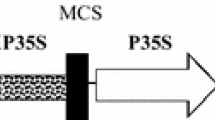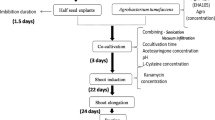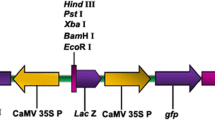Abstract
Cotyledonary node transformation efficiency was evaluated using a sonication assisted Agrobacterium-mediated transformation (SAAT) protocol, three dissimilar A. tumefaciens strains, and explants derived from 28 diverse cultivars and/or genotypes of soybean [Glycine max (L.) Merr.]. The explants were evaluated at 10 and 45 days after co-cultivation for transformation with a binary vector containing both a GUS-intron gene and an NPTII selectable marker. The best overall strain of A. tumefaciens was determined to be KYRT1 based on stable GUS transformation of soybean cotyledonary node explants measured at the terminal 45 day evaluation point. SAAT did not increase stable transformation at 45 days post co-cultivation. SAAT was determined to significantly decrease shoot proliferation of some genotypes, but it is unclear what effect this may have on the recovery of transformed shoots. Significant differences were also detected between genotypes for transformation and shoot proliferation frequency.
Similar content being viewed by others
Author information
Authors and Affiliations
Additional information
Received: 9 March 1998 / Revision received: 9 July 1998 / Accepted: 28 July 1998
Rights and permissions
About this article
Cite this article
Meurer, C., Dinkins, R. & Collins, G. Factors affecting soybean cotyledonary node transformation. Plant Cell Reports 18, 180–186 (1998). https://doi.org/10.1007/s002990050553
Issue Date:
DOI: https://doi.org/10.1007/s002990050553




